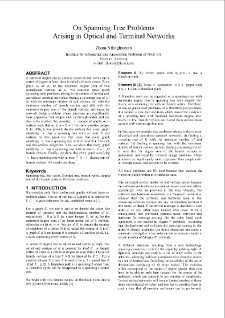Object
Title: On Spanning Tree ProblemsArising in Optical and Terminal Networks
Abstract:
A vertex of degree one in a tree is called an end vertex and a vertex of degree at least three is called a branch vertex For a graph G, let a2 be the minimum degree sum of two nonadjacent vertices in G. We consider three graph (spanning tree) problems arising in the context of optical and centralized terminal networks: finding a spanning tree of G: (i) with the minimum number of end vertices, (ii) with the minimum number of branch vertices and (iii) with the minimum degree sum of the branch vertices, motivated by network design problems where junctions are significantly more expensive than simple end- or through-nodes, and are thus to be avoided. We consider: (*) connected graphs on n vertices such that a2 > n — k + 1 for some positive integer fc. In 1976, it was proved (by the author) that every graph satisfying (*) has a spanning tree with at most k end vertices. In this paper we first show that every graph satisfying (*) has a spanning tree with at most k + 1 branch and end vertices altogether. Next, we show that every graph satisfying (*) has a spanning tree with at most (k — 1) /2 branch vertices. Finally, we show that every graph satisfying *) has a spanning tree with at most 3 ( k— 1) degree sum of branch vertices. All results are sharp.
Identifier:
oai:noad.sci.am:135978
Language:
URL:
Affiliation:
Institute for Informatics and Automation Problems
Country:
Year:
Time period:
Conference title:
10 th International Conference on Computer Science and Information Technologies CSIT 2015
Place:
Participation type:
Object collections:
- Digital Library > Academic Insitutions > Insitute for Informatics and Automation Problems of NAS RA > Conferences
Last modified:
Mar 4, 2021
In our library since:
Jul 28, 2020
Number of object content hits:
107
All available object's versions:
https://noad.sci.am/publication/149589
Show description in RDF format:
Show description in OAI-PMH format:
| Edition name | Date |
|---|---|
| Zhora Nikoghosyan, On Spanning Tree ProblemsArising in Optical and Terminal Networks | Mar 4, 2021 |





